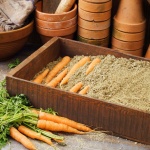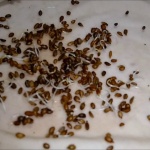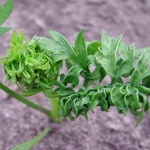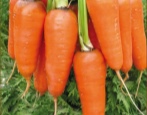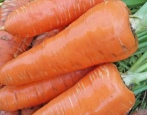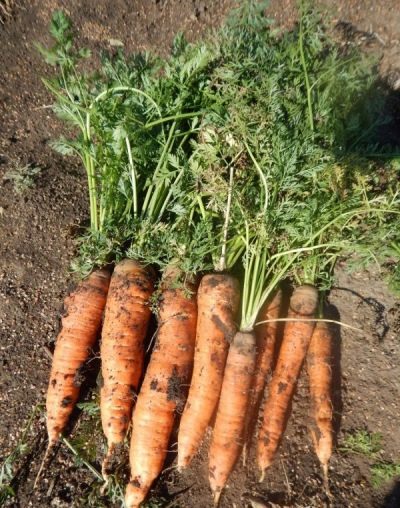
- Authors: Nastenko N.V., Kachainik V.G., Kandoba A.V.
- Year of approval: 2010
- Appointment: for fresh consumption, for freezing, for bundled products, for making juice
- Leaf rosette shape: sprawling
- Leaves: medium, green, fine to medium dissected
- Weight, g: 95-170
- The form : conical with blunt tip
- Taste qualities: excellent
- Composition : dry matter 14.0-15.0%, total sugar 6.0-7.5%, carotene up to 16.0 mg per 100 g of raw matter
- Ripening terms: mid-season
When planning spring plantings in the garden or summer cottage, there is always a place for carrots. An excellent variety that adapts well to the climate is the mid-season Caramelka carrot, bred by Russian scientists.
Breeding history
Carrots Caramel was obtained as a result of the efforts of a group of breeders of the agrofirm "Aelita" in 2006. The authorship belongs to A. V. Kandoba, V. G. Kachainik and N. V. Nastenko. After variety trials, in 2010, the vegetable was entered into the State Register of Breeding Achievements. Initially, the variety was created for cultivation in the Volga-Vyatka region, but over time, carrots have become popular in southern and central Russia. In addition, vegetable growers from Moldova and Ukraine are very fond of caramel.
Description of the variety
Caramel is a plant with a powerful rosette, which is characterized by good spreading. The leaves of the tops are of medium length - 15-20 cm, neat, with small and larger cuts. The color of the foliage is emerald green, uniform. Sometimes, due to their own severity, the leaves can bend and even creep.
The crop belongs to the Flakke cultivar. The carrot variety is characterized by resistance to blooming and cracking.
Characteristics of the appearance of the plant and root crops
Caramel is a representative of medium-sized varieties. Vegetables ripen neat and leveled. The average weight of the root vegetable varies from 95 to 175 grams. The length of the vegetable is average - 15-16 cm. The shape of the carrot is conical with a rounded / blunt "nose". The peel (bark) of the fruit is thin, smooth, with a pronounced gloss and a minimum number of filamentous roots. The ripe root crop has a uniform bright orange color.
The harvested crop is easy to transport, and can also be stored for a long time in appropriate conditions - in a cool, dry and dark place. The output of marketable root crops ranges from 67-87%.
Purpose and taste of tubers
The vegetable is famous for its excellent taste and valuable vitamin composition. The orange flesh has a tender, fleshy, slightly crunchy and juicy consistency without fiber. The taste is dominated by sweetness and pleasant sugariness, combined with a bright carrot aroma. The core is very thin, completely indistinguishable in color from the pulp. The content of sugars and carotene in the vegetable is high.
Dug / plucked carrots can be added to hot and cold dishes, used for canning vegetables, frozen, pickled, and processed into juice. Due to its long keeping quality, the vegetable is ideal for harvesting for the winter.
Maturation
In terms of ripening, Caramel belongs to the class of mid-season. The growing season lasts about 4 months (110-120 days). You can evaluate the taste of the first root crops after 70 days, and full technical maturity occurs on the 110-120th day.Fully ripe root vegetables accumulate the maximum amount of sugar and vitamins. Harvesting begins in mid-July and lasts until the end of September.
Yield
The variety has a good yield. In a favorable environment, up to 4 kg of vegetables are harvested from 1 m2. On an industrial scale, yield indicators are 236-367 c / ha.
Growing and care
The vegetable is cultivated by the seed method. To do this, shallow grooves (1-2 cm) are made in a previously prepared area, which moisturize well. Seeds are sown in late April - early May, when the air and soil warmed up to + 7-8 degrees, and the threat of return spring frosts was left behind.
The distance between the rows should be at the level of 20 cm. Sowing of seeds is carried out according to the scheme of 20x4 cm. Cucumbers, tomatoes, early types of potatoes, legumes will be good predecessors for Caramel carrots.
The agricultural technology of the vegetable is simple - the carrots need to be watered with settled water, 2-3 times to apply supporting fertilizers, regularly loosen the soil so that there is no crust, remove weeds and other debris, carry out thinning, keeping the distance between plants 4-5 cm, and also protect from viruses and pest infestations.
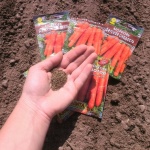
Carrots are one of the most unpretentious crops in terms of growing conditions; they can endure a short drought and a short cold snap. However, to get tasty and large root crops, you should adhere to the basic rules for planting carrots.

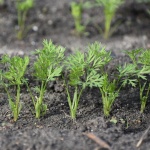
Soil requirements
The vegetable crop has certain requirements for the structure and composition of the soil. Carrot soil prefers light, loose, well-fertilized and moisturized soil. Often, a vegetable is planted in sandy loam or sandy soils with a neutral acidity index. In addition, planting carrots in swampy soils is not recommended.
Required climatic conditions
It is advisable to plant carrots on small hills or plains. The site should be sunny, warm, humid. Despite its good stress resistance, the culture is vulnerable to sharp temperature fluctuations and prolonged shading, which inhibits the development and maturation of root crops.
Disease and pest resistance
Due to good immunity, carrots are able to withstand many standard diseases. The most dangerous for vegetable crops are bear, wireworm and carrot fly. To prevent infection and infestation of parasites, it is enough to provide the plant with basic care - to remove weeds in a timely manner, prevent thickening, maintain moisture and plant aromatic crops nearby that repel insects (cilantro, garlic, marigolds, onions).

Carrots grow in almost any garden. There is an opinion that this culture is very resistant to all kinds of diseases and pests, but this is not the case. Without proper care, carrots become susceptible to all kinds of infections and are affected by harmful insects.

